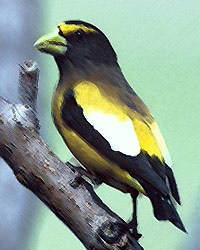 The populations of 20 common US birds — including a range of familiar “backyard birds” such as sparrows, chickadees, whippoorwills, and larks — are in decline, according to a new report from The National Audobon Society. The 20 species in question have less than half the populations they did in 1967. A variety of factors are to blame, including loss of habitat due to suburban sprawl, climate change, and invasive species.
The populations of 20 common US birds — including a range of familiar “backyard birds” such as sparrows, chickadees, whippoorwills, and larks — are in decline, according to a new report from The National Audobon Society. The 20 species in question have less than half the populations they did in 1967. A variety of factors are to blame, including loss of habitat due to suburban sprawl, climate change, and invasive species.
Nationwide, the most devastated population is that of the evening grosbeak (at right):
Some of the birds, such as the evening grosbeak, used to be so plentiful that people would complain about how they crowded bird feeders and finished off 50-pound sacks of sunflower seeds in a few days. But the number of colorful and gregarious grosbeaks has plummeted 78 percent in the past 40 years.
Our old friend Bob White is in trouble as well:
The northern bobwhite and its familiar wake-up whistle once seemed to be everywhere in the East. Last Christmas, volunteer bird counters could find only three and only 18 Eastern meadowlarks in Massachusetts.
The bobwhite had the biggest drop among common birds. In 1967, there were 31 million of this distinctive plump bird. Now they number closer to 5.5 million.
The Chicago Tribune says Illinois birds have been particularly hard hit.
In four decades, Illinois’ populations of bobolinks, black grassland songbirds with a white back and a yellow nape, dropped 97 percent, according to the study. Eastern meadowlarks’ numbers dropped 87 percent. The short-eared owl population plummeted by more than half.
Loss of habitat is especially key here:
The state has lost more than 99 percent of its original prairie and 90 percent of its original wetland acreage to development and agriculture.
… The findings tell a story bigger than a few bird species because they serve as indicators of the health of entire ecosystems, said Chicago region Audubon Director Stephen Packard.
“These birds are just the tip of a melting iceberg,” he said.
… a particularly well-turned metaphor given the climate change dimension of all this.
Devilstower has a thoughtful post on the subject at Daily Kos, and asks:
It’s one thing to hear that the last representative of some exotic and endangered species has passed away. But are we ready to live without meadowlarks? Without bobwhites? Without whippoorwills? We’re not there yet, but if we don’t do something to address sprawl and the growing demand for resources, we soon will be.
I often wonder what it will take to get through to the people who don’t understand why wetlands conservation matters, the global warming denialists, the “earth is not fragile” crowd. I’d like to think the idea of back yards without birdsong might make a dent, but then again, that would imply better listening skills than have previously been demonstrated.

No Comments so far ↓
Like gas stations in rural Texas after 10 pm, comments are closed.